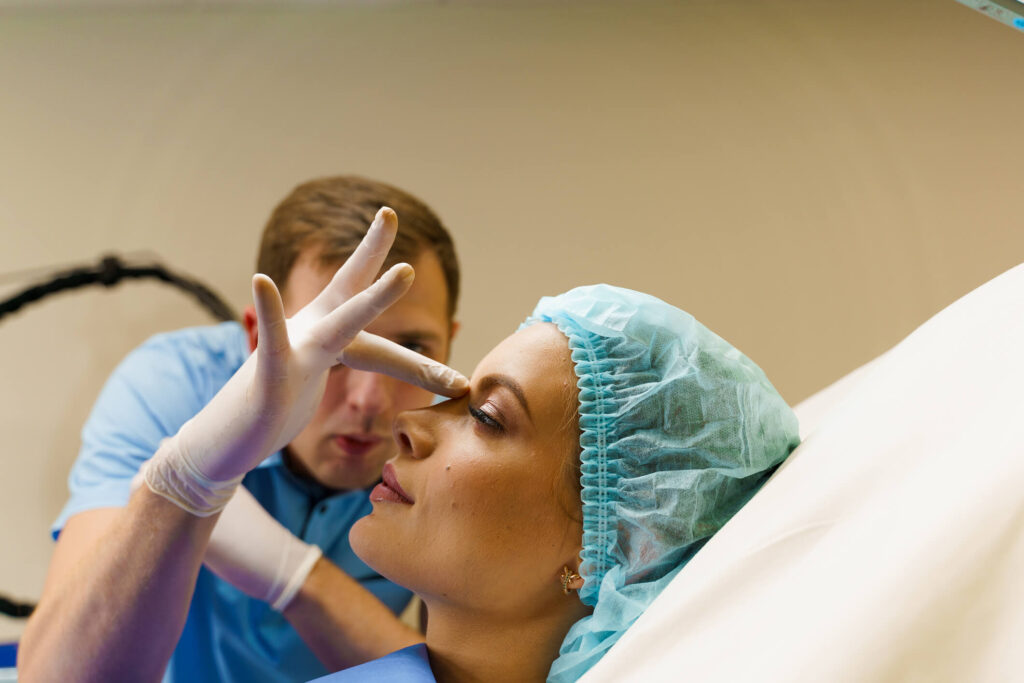What to Expect During Your First Rhinoplasty Consultation
If you’re considering rhinoplasty surgery, the first important step is scheduling a consultation with a qualified nose surgeon. This initial meeting allows you to discuss your questions, concerns, expectations, and goals while clearly understanding the procedure, recovery process, risks, and benefits. The assessment will include a detailed anatomy review, helping your doctor determine the best approach for your nose surgery.
A rhinoplasty consultation is more than just an evaluation—it’s an essential part of the process, allowing you to explore different procedures, techniques, and outcomes to achieve the desired appearance. Whether you’re looking to refine your nose structure, improve breathing, or correct a previous surgery, a consultation with Dr. Brennan ensures you make an informed decision guided by expert care.
The Importance of a Rhinoplasty Consultation
Every patient has unique features and reasons for considering a nose job. Some people seek cosmetic enhancement, while others require reconstructive surgery due to injury or congenital issues. Regardless of the motivation, a rhinoplasty surgeon will assess various factors and examine the specific details of each case before recommending a treatment plan. With the expertise of Dr. Brennan, you can explore the best way to achieve your desired results. These things are essential in ensuring a successful outcome, and a well-structured approach and a trusted logo in the field—help provide confidence in your decision.
Key Discussion Points During a Consultation
During your appointment, your doctor will cover several essential aspects:
- Medical History & Evaluation – Your surgeon will review your medical history, previous surgeries, current medications, supplements, and health conditions to determine if you’re a good candidate for rhinoplasty. Staying informed about the latest news in the field can also help you understand potential changes in surgical techniques and recovery methods.
- Facial Examination & Nose Structure – A thorough examination of your skin, cartilage, nasal passages, and overall facial balance will help plan the best procedure for optimal outcomes. Your eyes and surrounding facial features will also be considered to ensure a natural and harmonious result.
- Surgical & Non-Surgical Options – Some patients may benefit from non-invasive fillers for minor enhancements, while others require complete surgery involving implants, septoplasty, or laser treatments. A well-researched list of available techniques will help in making an informed decision.
- Expected Results & Recovery Timeline—Your doctor will outline the expected healing process, potential complications, and the time required for recovery after surgery. Researching post-surgical care and success stories can give you insight into what to expect.
- Before-and-After Photographs – Reviewing photographs of past cases can help set realistic expectations and showcase what is achievable. Understanding how changes in nasal structure affect overall facial harmony can help you visualize your transformation.
Understanding the Rhinoplasty Procedure
A rhinoplasty procedure can involve various techniques depending on the patient’s goals and anatomical structure. The most common methods include:
- Open Rhinoplasty – The surgeon makes a small incision at the base of the nose, lifting the skin to access internal structures. This approach provides more control over reshaping the cartilage and nasal bones. One key tip is that this method allows for detailed adjustments that may better align with your long-term journey for a more balanced face.
- Closed Rhinoplasty – All incisions are made inside the nostrils, leaving no visible scars. This method is ideal for minor adjustments. Patients who choose this route often share their views through online posts, showcasing their satisfaction with a smoother, more refined nose shape.
- Revision Rhinoplasty – Patients unsatisfied with previous nose surgery may require a secondary procedure to correct concerns and improve results. Reviewing photos from similar cases can help clarify potential outcomes and alleviate doubts.
- Non-surgical rhinoplasty involves using fillers to reshape minor imperfections without surgery. For many, this option offers a quick solution and minimal recovery time. It’s also important to stay updated with new posts from surgeons or patients who have undergone this technique, as these can provide valuable insights into the process.
Each method has different risks, benefits, and recovery timelines, all of which will be discussed during your consultation to help you choose the best option for your needs.
Expert Rhinoplasty Care with Dr. George Brennan
If you’re looking for a highly skilled rhinoplasty surgeon, Dr. George Brennan is a trusted name in plastic surgery. With extensive experience in performing nose surgery, he provides personalized treatment plans tailored to each patient’s unique features, goals, and expectations. His practice offers other procedures, including facelift, liposuction, breast augmentation, and skin rejuvenation.
Dr. Brennan uses advanced computer imaging techniques to help patients visualize their potential outcomes before committing to surgery. He takes the time to explain each detail of the process, allowing you to explore the possibilities that best suit your goals. Whether you’re a woman seeking to refine the structure of your nose or enhance your facial area, Dr. Brennan ensures that you clearly understand your options through pictures and consultations. His approach prioritizes safety, natural results, and patient satisfaction, making him a top choice for those considering rhinoplasty.
The Role of Imaging & Technology
Technology plays a crucial role in rhinoplasty consultations. Using computer imaging, patients can see simulated before-and-after previews, helping them make informed decisions about their surgery. This tool is handy for setting realistic expectations and discussing necessary modifications before proceeding. By visualizing how the nose tissues will change, patients better understand the potential outcome.
In addition to the advanced imaging tools, Dr. Brennan’s experienced staff offers expert guidance throughout the process. Whether you’re interested in Botox or other cosmetic enhancements, like removing skin imperfections, you’ll receive support tailored to your needs. The technology used in the practice is part of Dr. Brennan’s commitment to delivering the best care, making him a leader in the field, not just in the United States but worldwide.

Dr. George Brennan in Orange County California uses digital simulations to help patients visualize potential rhinoplasty results.
Post-Surgery Care & Recovery
After surgery, proper care is essential to ensure a smooth recovery and optimal results. Key aspects of post-operative care include:
- Managing Swelling & Pain – Swelling and minor pain are expected after surgery. Cold compresses and prescribed medications can help manage discomfort. The bridge of the nose and surrounding areas may experience some tenderness, but these symptoms should subside with time.
- Following Post-Surgery Instructions – Patients should follow their surgeon’s advice regarding sleeping position, activity restrictions, and wound care. This is important to ensure the nose’s proper form and prevent any unnecessary stress on the healing tissues.
- Attending Follow-Up Appointments – Regular check-ups with your plastic surgeon ensure proper healing and address any concerns. During these visits, the surgeon will monitor the healing progress of the bridge and any changes in the forehead or surrounding areas.
- Avoiding Strenuous Activities – Patients should avoid heavy lifting, intense exercise, and activities that could impact the nose structure during the initial healing process. Taking it easy in the first few weeks will help preserve the form of the nose as it heals.
Choosing the Right Surgeon
Selecting an experienced nose surgeon is crucial for achieving the best possible outcomes. When researching rhinoplasty surgeons, consider the following:
- Board Certification & Experience – Ensure the doctor is board-certified and has extensive experience in rhinoplasty procedures.
- Before-and-After Photographs – Reviewing past cases helps gauge the surgeon’s skill and ability to create natural-looking results.
- Patient Reviews & Testimonials – Look for positive reviews from previous patients to understand the overall experience and satisfaction rates.
- Consultation Approach – A good surgeon should provide a thorough consultation, answer all questions, and set realistic expectations.
Final Thoughts
A rhinoplasty consultation is a crucial step in nose surgery. It provides essential information about the procedure, risks, benefits, recovery process, and expected results. Whether seeking cosmetic enhancement or functional improvements, working with an experienced plastic surgeon like Dr. George Brennan ensures high-quality care and professional expertise.
Consult a trusted surgeon today if you’re ready to explore your rhinoplasty options. You can also follow Dr. Brennan’s practice on Instagram to see real before-and-after photographs, patient reviews, and expert advice. Take the first step toward achieving your aesthetic goals with confidence!
Frequently Asked Questions
It’s natural to have several questions before undergoing plastic surgery. Some of the most common concerns include:
What is the difference between cosmetic and functional rhinoplasty?
Cosmetic rhinoplasty focuses on changing the nose’s appearance, while functional rhinoplasty addresses structural issues that affect breathing, such as a deviated septum or nasal blockages.
Can rhinoplasty fix a broken nose?
Rhinoplasty can repair a broken nose, restoring its structure and function. It can also address deformities caused by trauma while improving its aesthetic appearance.
Can rhinoplasty be done with other cosmetic procedures?
Rhinoplasty can be combined with other procedures, such as facelifts, chin implants, or eyelid surgery, to enhance overall facial harmony. Your surgeon will discuss the possibilities during the consultation.
How much does rhinoplasty cost?
The cost of rhinoplasty varies based on factors like location, surgeon expertise, and the complexity of the procedure. It’s important to discuss pricing during the consultation and review what’s included in the cost.
Is there any non-surgical alternative to rhinoplasty?
Yes, non-surgical rhinoplasty involves using injectable fillers to reshape the nose. This is a temporary solution, and the results typically last between 6 to 18 months, depending on the type of filler used.
How soon can I return to work after rhinoplasty?
Recovery times vary, but most people can return to work after about one week, provided the work does not involve strenuous activities. Light work is typically fine, but you should avoid physical exertion for a few weeks to allow for proper healing.
What Are the Risks of Rhinoplasty?
Like any surgical procedure, rhinoplasty carries certain risks, including swelling, pain, infection, breathing issues, and anesthesia-related complications. However, working with an experienced plastic surgeon can significantly reduce these risks.
How Long Is the Recovery Process?
The healing process varies among patients, but most experience noticeable improvement within two weeks. Swelling can take several months to subside entirely, revealing the final results. Following post-operative care instructions is crucial for a smooth recovery.
Will There Be Scarring?
With closed rhinoplasty, scars are hidden inside the nostrils. For open rhinoplasty, the small incision at the nose base typically heals well and becomes almost invisible over time.
How Should I Prepare for Surgery?
Preparation includes stopping certain medications, supplements, and smoking and arranging time off work to ensure proper recovery. Your doctor will provide a detailed plan during your appointment.

